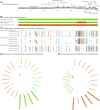Culture and identification of a "Deltamicron" SARS-CoV-2 in a three cases cluster in southern France
- PMID: 35467028
- PMCID: PMC9088576
- DOI: 10.1002/jmv.27789
Culture and identification of a "Deltamicron" SARS-CoV-2 in a three cases cluster in southern France
Abstract
Multiple SARS-CoV-2 variants have successively, or concomitantly spread worldwide since the summer of 2020. A few co-infections with different variants were reported and genetic recombinations, common among coronaviruses, were reported or suspected based on co-detection of signature mutations of different variants in a given genome. Here we report three infections in southern France with a Delta 21J_AY.4-Omicron 21K/BA.1 "Deltamicron" recombinant. The hybrid genome harbors signature mutations of the two lineages, supported by a mean sequencing depth of 1163-1421 reads and a mean nucleotide diversity of 0.1%-0.6%. It is composed of the near full-length spike gene (from codons 156-179) of an Omicron 21K/BA.1 variant in a Delta 21J/AY.4 lineage backbone. Importantly, we cultured an isolate of this recombinant and sequenced its genome. It was observed by scanning electron microscopy. As it is misidentified with current variant screening quantitative polymerase chain reaction (qPCR), we designed and implemented for routine diagnosis a specific duplex qPCR. Finally, structural analysis of the recombinant spike suggested its hybrid content could optimize viral binding to the host cell membrane. These findings prompt further studies of the virological, epidemiological, and clinical features of this recombinant.
Keywords: Omicron; SARS-CoV-2; delta; deltamicron; epidemic; lineage; recombinant; variant.
© 2022 Wiley Periodicals LLC.
Conflict of interest statement
Didier Raoult has a conflict of interest as having been a consultant for Hitachi High‐Technologies Corporation, from 2018 to 2020. He is a scientific board member of Eurofins company and a founder of a microbial culture company (Culture Top). All other authors have no conflicts of interest to declare. Funding sources had no role in the design and conduct of the study; collection, management, analysis, and interpretation of the data; and preparation, review, or approval of the manuscript.
Figures



References
-
- Hodcroft EB, Zuber M, Nadeau S, et al. Emergence and spread of a SARS‐CoV‐2 variant through Europe in the summer of 2020. Nature. 2021;595:707‐712. - PubMed
Publication types
MeSH terms
Supplementary concepts
LinkOut - more resources
Full Text Sources
Other Literature Sources
Medical
Research Materials
Miscellaneous

